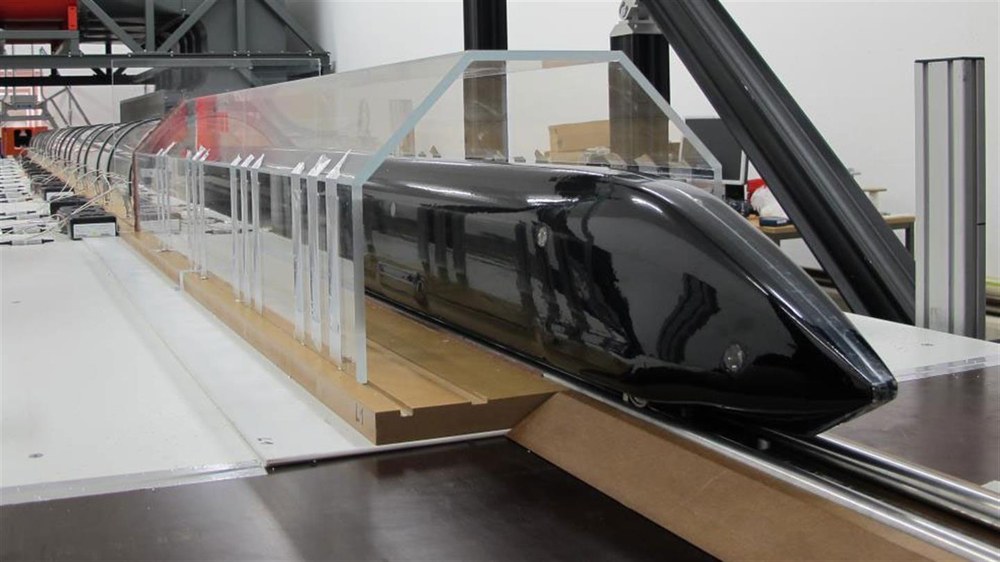DLR at InnoTrans 2018 – a high-speed train for the freight transport of the future



- DLR will present its current rail research projects at InnoTrans in Berlin from 18 to 21 September 2018
- The holistic logistics concept NGT Cargo aims to increase the attractiveness of future rail freight transport
- DLR researchers are making rail transport more economical, safer, more energy-efficient and more environmentally friendly
- Focus: Mobility, energy, transport, security, rail transport of the future
From 18 to 21 September 2018, the German Aerospace Center (Deutsches Zentrum für Luft- und Raumfahrt; DLR) will be showcasing what the trains of tomorrow might look like and how we can make rail transport safer, more energy-efficient and more environmentally friendly at InnoTrans, the International Trade Fair for Transport Technology, held in Berlin. The scientists will present the entire spectrum of current DLR rail research, including the NGT Cargo, a high-speed train for future freight transport (Hall 2.2, Stand 404).
"With its research, DLR not only looks at rail vehicles, but rather at the complete transport chain – from sender to receiver. The reinforcement of rail transport as a competitive mode of transport is an important element of the transport revolution. To make rail more attractive for cargo and passenger transport, we have to increase its capacity, speed, reliability and cost-effectiveness. As a federal rail transport research institution, DLR is making a significant contribution to this objective. DLR is developing a vision for future cargo transport, as part of an integrated logistics concept, and driving concrete technological innovations," says Karsten Lemmer, DLR Executive Board Member for Energy and Transport.
From road to rail – a mobility concept for freight transport
DLR scientists have developed the NGT Cargo to counteract problems such as particulate matter, traffic noise and congestion. This is a logistics concept for future cargo transport, aimed at increasing the efficiency of rail transport and shifting cargo transport from road to rail. In addition to research on the vehicle itself, the project takes into consideration the entire transport chain – from sender to recipient. This also includes loading and unloading facilities, handling facilities and an operational concept incorporating urban distribution. The NGT CARGO train developed for that purpose is composed of individual cargo wagons and high-performance locomotives. NGT CARGO wagons can be autonomously driven individually or as a group.
With a loud bang – aerodynamic studies on the tunnel entrance
When a train enters a tunnel at a speed of around 400 kilometres per hour, it generates pressure waves that shoot through it at the speed of sound. This not only creates a heavy load on the infrastructure of the tunnel, but also a loud noise, similar to an explosion. Using a 1:25 scale model of the NGT CARGO, DLR researchers will demonstrate how these effects can be mitigated. This involves attaching special hoods to the portals of the tunnel, for example, from which air can escape sideways or upwards through special inlets.
Alternative drive systems
Around half of the EU's rail network is not electrified, as full electrification would not be economically feasible in many places. As such, alternative drive concepts have to be adapted to the respective locations. DLR is thus working on alternative vehicle and infrastructure concepts for different technological and operational framework conditions for rail transport.
Strong crosswinds – stabilising high-speed trains
DLR is developing efficient and sustainable high-speed trains in its Next Generation Train (NGT) research project. Its key features are a double-decker design, lightweight construction and a maximum operating speed of 400 kilometres per hour. However, these also require special measures to ensure driving stability in strong crosswinds. DLR uses electromagnets that keep the train on the rails and stabilise it in strong side winds using the strongest possible magnetic holding power.
Condition-based maintenance – predictive repairs
Up until now, railroad switches and tracks have been maintained or replaced in fixed cycles. DLR is looking at how to maintain rail transport infrastructure before it becomes damaged or suffers malfunctions. The basic prerequisites for this are continuous, automatic condition monitoring of the relevant assets during operation, as well as the ability to automatically diagnose and predict the status of the system based on an extensive and complex pool of data (Big Data). At InnoTrans, DLR will be showcasing its progress in embedded rail monitoring with conventional rail vehicles, switches and cable systems for electronic interlocking stations.
